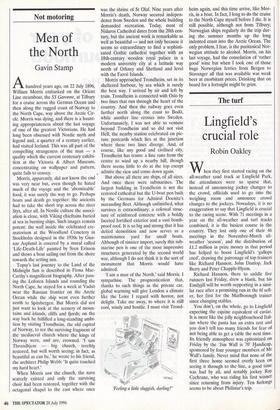Not motoring
Men of the North
Gavin Stamp Ahundred years ago, on 22 July 1896, William Morris embarked on the Orient Line steamboat, the SS Garonne, at Tilbury for a cruise across the German Ocean and then along the rugged coast of Norway to the North Cape, way above the Arctic Cir- cle. Morris was dying, and there is a haunt- ing appropriateness about the last voyage of one of the greatest Victorians. He had long been obsessed with Nordic myth and legend and, a quarter of a century earlier, had visited Iceland. This was all part of the compelling strangeness of the man — a quality which the current centenary exhibi- tion at the Victoria & Albert Museum, concentrating on wallpaper and pattern, quite fails to convey.
Morris, apparently, did not know the end was very near but, even though he hated much of the voyage and the 'abominable' food, it was surely the way to go. Perhaps boats and death go together: the ancients had to take the short trip across the river Styx, after all. In Nordic culture the associ- ation is close, with Viking chieftains buried at sea in burning ships. Such images remain potent: the wall inside the celebrated cre- matorium at the Woodland Cemetery in Stockholm designed in the 1930s by Gun- nar Asplund is covered by a mural called 'Life-Death-Life' painted by Sven Erixson and shows a boat sailing out from the shore towards the setting sun.
Topsy's last journey to the Land of the Midnight Sun is described in Fiona Mac- Carthy's magnificent biography. After pass- ing the Lofoten Islands and rounding the North Cape, he stayed for a week at Vadso near the Russian frontier on the Arctic Ocean while the ship went even further north to Spitsbergen. But Morris did not just want to look at the scenery of moun- tains and islands, cliffs and fjords; on the way back he fulfilled a long-standing ambi- tion by visiting Trondheim, the old capital of Norway, to see the surviving fragment of the mediaeval church where the kings of Norway were, and are, crowned. 'I saw Throndhjem — big church, terribly restored, but well worth seeing; in fact, as beautiful as can be,' he wrote to his friend, the architect Philip Webb. 'It quite touched my hard heart.'
When Morris saw the church, the nave scarcely existed and only the surviving choir had been restored, together with the octagonal chapel to the east where once was the shrine of St Olaf. Nine years after Morris's death, Norway secured indepen- dence from Sweden and the whole building demanded recreation. Today, most of Nidaros Cathedral dates from the 20th cen- tury, but the ancient work is remarkable as well as beautiful — and not only because it seems so extraordinary to find a sophisti- cated Gothic cathedral together with an 18th-century wooden royal palace in a modern university city at a latitude way north of Orkney and Shetland and level with the Faroe Islands.
Morris approached Trondheim, set in its sheltered harbour, by sea which is surely the best way. I arrived by air and left by train. Trondheim is connected with Oslo by two lines that run through the heart of the country. And then the railway goes even further north along the coast to Bode, while another line crosses into Sweden. Unfortunately, I was not able to venture beyond Trondheim and so did not visit Hell, the nearby station celebrated on pic- ture postcards which lies at the junction where these two lines diverge. And, of course, like any good and civilised city, Trondheim has trams: a line runs from the centre to wind up a nearby hill, though there seems little to do at the top except admire the view and come down again.
But above all there are ships, of all sizes. And once there were submarines. The largest building in Trondheim is not the restored cathedral but the U-boat pen built by the Germans for Admiral Doenitz's marauding fleet. Although unfinished, what survives is extraordinary: a colossal struc- ture of reinforced concrete with a boldly faceted fortified exterior and a vast bomb- proof roof. It is so big and strong that it has defied demolition and now serves as a maintenance yard for small boats. Although of sinister import, surely this sub- marine pen is one of the most impressive structures generated by the second world war, although I do not think it is the sort of monument that Morris would have admired.
'I am a man of the North,' said Morris. I sympathise. The prognostication that, thanks to such things as the private car, global warming will give London a climate like the Loire I regard with horror, not delight. Take me away, to where it is still cool, windy and hostile. I must visit Trond-
Feeling a little sluggish, darling?'
heim again, and this time arrive, like Mor- ris, in a boat. In fact, I long to do the cruise to the North Cape myself before I die. It is still possible, although not from Tilbury; Norwegian ships regularly do the trip dur- ing the summer months up the long indented coast into the Arctic Ocean. The only problem, I fear, is the puritanical Nor- wegian attitude to alcohol. Morris, on his last voyage, had the consolation of 'rather good' wine but when I took one of those huge Norwegian ferries from Bergen to Stavanger all that was available was weak beer at exorbitant prices. Drinking that on board for a fortnight might be grim.


























































 Previous page
Previous page